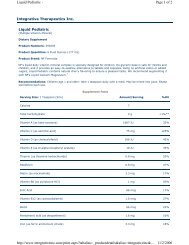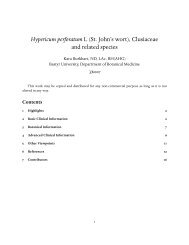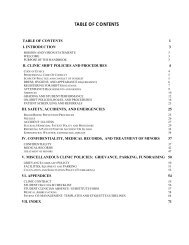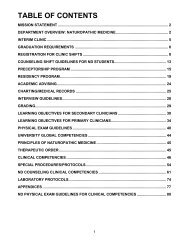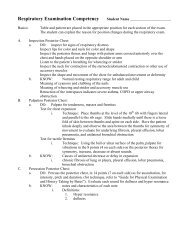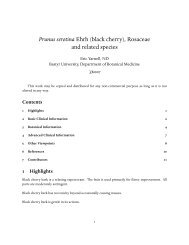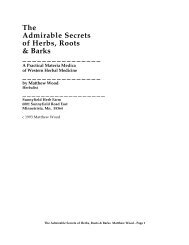Cinchona officinalis L (Peruvian bark), Rubiaceae ... - AaronsWorld
Cinchona officinalis L (Peruvian bark), Rubiaceae ... - AaronsWorld
Cinchona officinalis L (Peruvian bark), Rubiaceae ... - AaronsWorld
You also want an ePaper? Increase the reach of your titles
YUMPU automatically turns print PDFs into web optimized ePapers that Google loves.
3.5 Ecological Status<br />
Moderately threatened by logging and harvesting for medicine, though medicinal harvesting has been<br />
greatly reduced by availability of cultivated stock.<br />
3.6 Cultivation<br />
Extremely complex and difficult, but now widely established in India, Indonesia and Zaire.<br />
3.7 Wildcrafting<br />
Unclear to what extent this is still practiced due to large-scale cultivated supplies.<br />
4 Advanced Clinical Information<br />
4.1 Additional Actions<br />
¯ Schizontocidal against Plasmodium spp, useful for treatment and suppression.<br />
¯ Anti-ameba (Borris and Schaeffer 1992)<br />
¯ Inhibition of muldrug resistance pump<br />
¯ Negative inotropic<br />
¯ Insulin secratagogue<br />
<strong>Cinchona</strong> alkaloids act primarily as blood schizonticides. Schizonts are the form of malaria that<br />
exist in red blood cells before giving rise to merozoites, which reinvade red blood cells and split into<br />
sexual forms that penetrate into mosquitoes. Quinine also kills these sexual forms (gametocytes)<br />
for the P. malariae and P. vivax forms. Though quinine and related alkaloids may have some effect<br />
against sporozoites that come out of mosquitoes and actually start a malaria infection, they are not<br />
well-established for preventing malaria, though historical reports suggest they might be protective.<br />
Quinine and related alkaloids do not appear to affect the hynozoites that persist in the liver or any<br />
exoerythrocytic forms of malaria, and thus cannot completely eradicate (cause a so-called radical cure)<br />
malaria on their own in patient infected with P. ovale or P. vivax, which have exoerythrocytic forms.<br />
4.2 Additional Indications<br />
¯ Leg cramps<br />
¯ Babesiosis<br />
¯ Amebiasis<br />
¯ Cancer chemotherapy resistance reversal<br />
Mixed results in controlled clinical trials led to FDA revoking the over-the-counter status for quinine<br />
used to treat leg cramps in 1995 (Man-Son-Hing and Wells 1995).<br />
In a phase I trial, intravenous cinchonine appeared to reverse multidrug resistance in patients with<br />
lymphoproliferative syndromes treated with chemotherapy, but there was concern about potential for<br />
8



